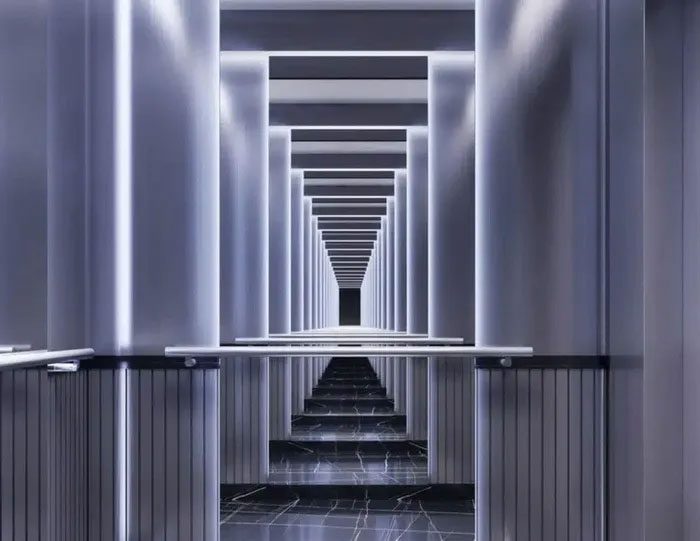The Infinity Mirror effect occurs when two mirrors are placed opposite each other, creating a reflection of an object that appears multiple times, creating the illusion of countless replicas extending infinitely into the distance.
When two mirrors are positioned facing each other, they create an intriguing optical phenomenon known as the Infinity Mirror effect. You can observe this effect when standing between two parallel reflecting mirrors in a mirror room, dressing rooms, or certain elevators.

Infinity mirror effect when two mirrors are placed opposite each other. (Source: BBC).
When gazing into two parallel mirrors, you see your own reflection while also catching a glimpse of the reflection of the other mirror behind you. In that reflection, you see a smaller version of yourself, and within that, there are even smaller reflections… This process continues, repeating as the reflections stretch out into the distance and become smaller.
An interesting aspect of the infinity mirror effect is how it can create a sense of depth and dimensionality. The gradually receding reflections give the impression of an endless space, as if the replicas of the object are extending infinitely into the distance.
But do mirrors facing each other really create an endless series of reflections?

Repeated reflections resembling an endless tunnel. (Source: Smore Science).
Theoretically, it is entirely possible, but with the mirrors currently in use, this cannot happen.
Common materials used to make mirrors, such as glass coated with a thin layer of silver and aluminum, will absorb a small amount of light with each reflection.
Each time light bounces back and forth between the mirrors, a tiny portion of it is absorbed or scattered. Therefore, with each reflection, the image will fade slightly. After many reflections, the light will eventually be completely absorbed, and at that point, the reflection process ends.
Rajesh Menon, a Professor of Electrical Engineering at the University of Utah (USA), stated: “If we had perfect mirrors, then the reflections would be infinite.”
A perfect mirror does not mean it reflects the most beautiful image, but rather it is a mirror that reflects 100% of the incoming light without absorbing any.
Professor Menon explained that the process of light reflection back and forth in mirrors follows the law of reflection.
According to this physical law, light striking and bouncing off a smooth surface reflects at equal angles. However, these reflections gradually lose their clarity.

Each reflection causes the images to fade slightly. (Source: Mind Matters)
Julie Bentley, a Professor of Optics at the University of Rochester, noted that each time light hits a mirror, only 90-98% is reflected, while the rest is absorbed. Consequently, with each reflection, the image becomes a little less distinct until there is not enough light to see.
This is why when you wave at your 100th reflection, it becomes very difficult to see it.
Professor Menon mentioned that with very good mirrors—those that absorb minimal light—you can create “thousands or tens of thousands of reflections.
Currently, there is no mirror material that can reflect 100% of visible light. However, this can be achieved with very specific parameters for a single wavelength or a “color” of light.
Menon stated: “This is usually achieved by eliminating transmitted light through a phenomenon known as “destructive interference,” referring to the phenomenon where light passes through a medium rather than being reflected or absorbed.
If you imagine a light wavelength as a string oscillating up and down, this phenomenon occurs when two wavelengths oscillate in completely opposite ways.
In other words, one string will have a peak while the other has a trough. As a result, the motion of both cancels each other out, which helps maximize the amount of reflected light.
While ordinary mirrors may not be perfect reflectors, creating thousands of reflections can have significant scientific implications.
For instance, they could be used to generate lasers or enhance the light absorption capability of solar panels to produce electricity, as noted by Bentley and Menon.



















































